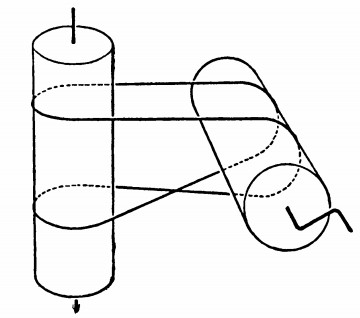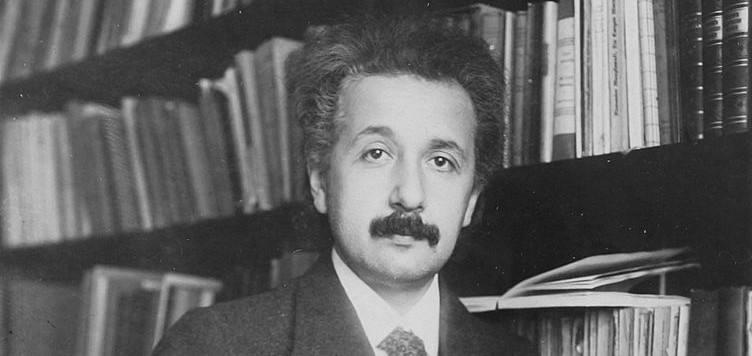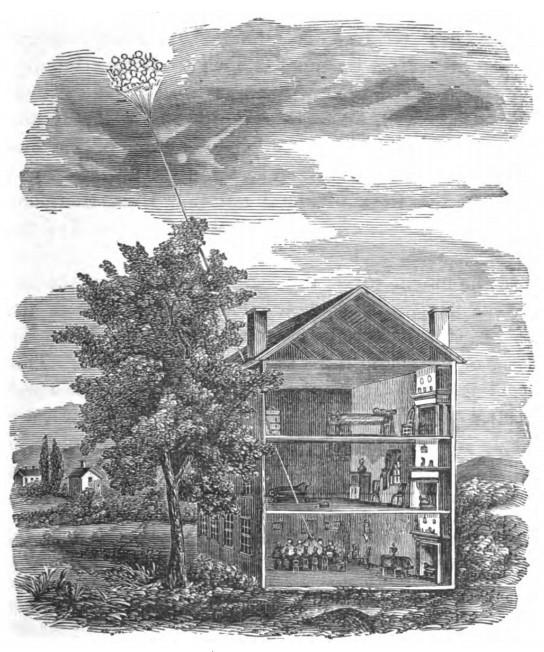{13, 40, 45}
The square of the sum of any two of these numbers minus the square of the third is a square:
(13 + 40)2 – 452 = 282
(13 + 45)2 – 402 = 422
(40 + 45)2 – 132 = 842
(From Edward Barbeau’s Power Play, 1997.)
{13, 40, 45}
The square of the sum of any two of these numbers minus the square of the third is a square:
(13 + 40)2 – 452 = 282
(13 + 45)2 – 402 = 422
(40 + 45)2 – 132 = 842
(From Edward Barbeau’s Power Play, 1997.)

A curious phenomenon noted in Martyn Cundy and A.P. Rollett’s Mathematical Models (1951):
Two rollers are mounted on perpendicular axles in different planes. An endless thread passes round them and connects them, both directly and with a crossover, as shown in the diagram. The instrument is somewhat capricious, but the following phenomena can be demonstrated with it.
(a) One roller is rotated continuously in one direction. The other starts in one direction, but if temporarily stopped with the finger continues in the opposite direction.
(b) One roller is rotated to and fro through a small angle. The other roller rotates continuously in the same direction.
“The apparatus shows that dynamical friction is less than statical, but a full explanation is complicated, if indeed it is possible, and certainly involves consideration of the elasticity of the connecting belt.”

In June 1992, farmers draining ponds in Longyou County, Quzhou prefecture, Zhejiang province, China, discovered that they weren’t ponds at all but drowned caverns, apparently created during the Ming Dynasty.
To date 36 such caves have been discovered in a region of 1 square kilometer. They’ve been compared to underground palaces, with rooms, halls, pillars, beds, bridges, and pavilions. But their age and function remain unclear because no historical document mentions them.
(Cheng Zhu et al., “Lichenometric Dating and the Nature of the Excavation of the Huashan Grottoes, East China,” Journal of Archaeological Science 40:5 [2013], 2485-2492.)
In 2014, Princeton mathematician John Conway proposed a simple conjecture:
Let n be a positive integer. Write the prime factorization in the usual way, e.g. 60 = 22 × 3 × 5, in which the primes are written in increasing order, and exponents of 1 are omitted. Then bring exponents down to the line and omit all multiplication signs, obtaining a number f(n). Now repeat.
So, for example, f(60) = f(22 × 3 × 5) = 2235. Next, because 2235 = 3 × 5 × 149, it maps, under f, to 35149, and since 35149 is prime, we stop there forever.
The conjecture, in which I seem to be the only believer, is that every number eventually climbs to a prime. The number 20 has not been verified to do so. Observe that 20 → 225 → 3252 → 223271 → …, eventually getting to more than one hundred digits without reaching a prime!
Conway offered $1,000 for a counterexample, a number that doesn’t “climb to a prime.” The challenge stood for three years before James Davis, who calls himself “not a mathematician by any stretch,” found the pretty 13532385396179 = 13 × 532 × 3853 × 96179, a composite number that loops onto itself and thus never reaches a prime — a find worth $1,000.
It’s been established that a volume of fluid can be suspended stably above a layer of air by vibrating the whole system vertically. Now researchers in Paris have shown that lightweight objects can “float” on the underside of this suspended slab of liquid — thus inverting an entire seaside scene.
A YouTube commenter writes, “We’ve been sailing like that for years in Australia.”
(Benjamin Apffel et al., “Floating Under a Levitating Liquid,” Nature 585:7823 [2020], 48-52.)

What does the middle initial “B.” stand for in Benoit B. Mandelbrot’s name?
Benoit B. Mandelbrot.
In the Notices of the American Mathematical Society, Andrew Kern calls this “My single favorite math joke of all.”
(Intriguingly, Mandelbrot adopted his middle initial; it does not stand for a middle name.)
03/02/2021 UPDATE: Reader Dan Uznanski sent another:
What’s an anagram for Banach-Tarski?
Banach-Tarski Banach-Tarski.
I am nearly driven wild with the Dorcas accounts, and by Mrs. Wakefield’s orders they are to be done now. I do hate sums. There is no greater mistake than to call arithmetic an exact science. There are Permutations and Aberrations discernible to minds entirely noble like mine; subtle variations which ordinary accountants fail to discover; hidden laws of Number which it requires a mind like mine to perceive. For instance, if you add a sum from the bottom up, and then again from the top down, the result is always different. Again if you multiply a number by another number before you have had your tea, and then again after, the product will be different. It is also remarkable that the Post-tea product is more likely to agree with other people’s calculations than the Pre-tea result.
Try the experiment, and if you do not find it as I say, you are a mere sciolist, a poor mechanical thinker, and not gifted as I am, with subtle perceptions.
— Maria Price La Touche, The Letters of a Noble Woman, 1908

In 1927 Albert Einstein sent a photograph of himself to his friend Cornelia Wolf. He inscribed these lines:
Wherever I go and wherever I stay,
There’s always a picture of me on display.
On top of the desk, or out in the hall,
Tied round a neck, or hung on the wall.
Women and men, they play a strange game,
Asking, beseeching: “Please sign your name.”
From the erudite fellow they brook not a quibble,
But firmly insist on a piece of his scribble.
Sometimes, surrounded by all this good cheer,
I’m puzzled by some of the things that I hear,
And wonder, my mind for a moment not hazy,
If I and not they could really be crazy.
In 1865, while conducting the “Answers to Correspondents” column in The Californian, Mark Twain received this inquiry:
If it would take a cannon ball 3 1/3 seconds to travel four miles, and 3 3/8 seconds to travel the next four, and 3 5/8 to travel the next four, and if its rate of progress continued to diminish in the same ratio, how long would it take it to go fifteen hundred millions of miles?
He responded:
I don’t know.
In a 1906 address to the New York Association for Promoting the Interests of the Blind, he said, “I never could do anything with figures, never had any talent for mathematics, never accomplished anything in my efforts at that rugged study, and today the only mathematics I know is multiplication, and the minute I get away up in that, as soon as I reach nine times seven … [Mr. Clemens lapsed into deep thought for a moment.] I’ve got it now. It’s eighty-four.”

In his 1886 book The Present Age and Inner Life, “Poughkeepsie Seer” Andrew Jackson Davis gives a surprisingly concrete explanation of table-turning at a seance:
We are negative to our guardian spirits; they are positive to us; and the whole mystery is illustrated by the workings of the common magnetic telegraph. The principles involved are identical. The spirits (improperly so called) sustaining a positive relation to us, are enabled through mediums, as electric conductors, to attract and move articles of furniture, vibrate the wires of a musical instrument, and, by discharging, through the potencies of their wills, currents of magnetism, they can and do produce rappings, on principles strictly analogous to the magnetic telegraph, and may move tables or tip them, to signify certain letters of the alphabet.
In her 1972 study of the spiritualist movement, Georgess McHargue writes that Davis’ scientific passages are so packed with “gobbledegook as to put it in the class with the most imaginative vintage science fantasy.”